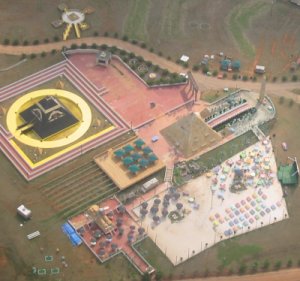The Nuwaubian movement began in the late 1960s under the guidance and vision of Dr. Dwight “Malachi” York. York, deeply involved with other black Islamic movements, broke away from these groups to begin his own. Under the name “Ansaar Pure Sufi,” York ‘s spiritual movement met in small groups across Brooklyn, with York keeping close contact with other leaders within black spiritual movements. However, York’s movement grew tremendously over the course of its forty years of activity and moved beyond the limits of pure spiritualism or religion to make claims and efforts toward separatism and broader societal autonomy.
During the Nuwaubians’ active period in New York, the group spent the majority of their history referring to themselves as the “Ansaaru Allah Community” (AAC). The ACC was a “messianic, millenarian, evangelistic and communal”1 Muslim movement, with York specifically drawing from other apogees within the culture of black Islam, including Marcus Garvey and Elijah Muhammad.2 The AAC incorporated the teachings of York on the origin of the black man and his relation to white society, along with the pathway to freedom for oppressed black society. While the Nuwaubians undergo many alterations and shifts in doctrine following their period of stability, the racial considerations that underpin their belief system remains a constant throughout the group’s history. This follows the assertion that “religious Black Nationalism was founded on the belief that religion should not just serve a spiritual purpose of redeeming the mind and soul, but also as a social instrument of empowerment via social justice.”3 This suggests a system of beliefs that are socially-validated, so that while doctrine shifts may occur, the underlying social truth that informs the beliefs–specifically racist American society in the case of the Nuwaubians–grounds these shifts so as to render them legitimate within the framework of the religious movement.

Examining the Nuwaubian movement, their extensive history and frequent locational and doctrine changes through this lens proves useful when examining their efforts toward separatism and later claims to sociopolitical autonomy. Following the group’s relocation to Eatonton, several revisions were made to the structural aspects of the movement that distinguishes the era of the Nuwaubians significantly from their time in Brooklyn. Primarily, the Nuwaubians make claim to Creek Nation heritage during their period of activity in Eatonton. This is significant on multiple accounts. First, there is this nebulous concept of the “nation,” which suggests “an imagined political community–and imagined as both inherently limited and sovereign.”4 When the Nuwaubians make claim to this Creek heritage, their desire for this sovereignty matures and becomes more explicit. The explicitly derives from Tama-Re, the compound that a significant number of Nuwaubians lived within and practiced their beliefs. The Egyptian-style compound housed hundreds of members of the group, from 100 to 500 residents, depending on sources.5 From this 476-acre territory, the group now has claims to a limited territory through which to assert their political autonomy.
The history of the Nuwaubians thus suggests a number of unique and pressing questions with regards to the nature of separatism and how separatist claims evolve over time. For the Nuwaubians, “their quest for autonomy and belief in cultural, social and political separation”6 functions as a core tenet of their overall belief system and evolved aesthetically in the same manner as their belief system. Although the separatist streak remained constant, acting as a consistent facet of their ever-evolving doctrine, the claims grew and nuanced as the group did, which suggests a greater truth about separatism itself. Separatism is a messy process, and it must be a live process, one not prone to or capable of stagnation. By constantly reforming and reasserting their boundaries and their own claims to a separate and autonomous society, the Nuwaubian group demonstrates this concept extensively, while still remaining dedicated to this core desire of religious, black separatism.
1 Susan Palmer, The Nuwaubian Nation: Black Spirituality and State Control (Farnham, Ashgate Publishing Limited, 2010), xv.
2 Ibid., 2.
3 Emeka C. Anaedozie, Post Civil Rights Black Nationalism: The Nuwaubian Nation of Moors’ Model, 1967-2002 (Morgan State University, 2013), 39.
4 Benedict Anderson, Imagined Communities (London, Verso, 2006), 6.
5 Anaedozie, Post Civil Rights Black Nationalism, 107.
6 Ibid., 166.
Photography
K. C. Budd., “Nuwaubian Air,” Phreak Monkey, digital, http://phreakmonkey.com/aviation/nuwaubian-air, (accessed October 28, 2018).